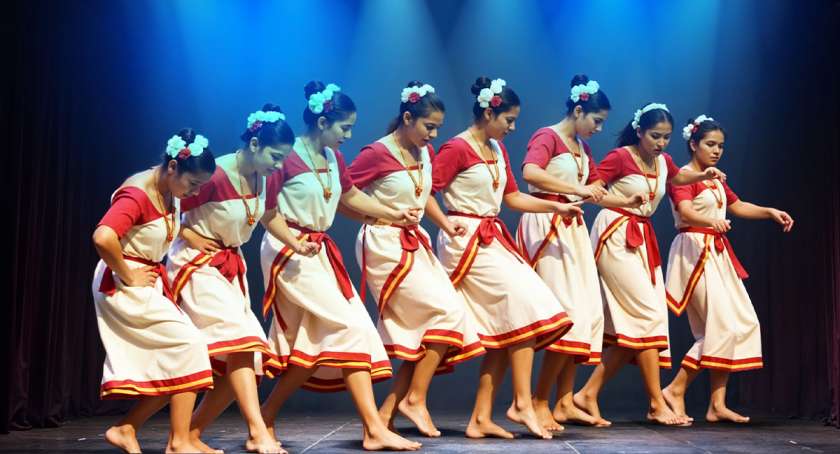Moving to the Melodies of Tradition – Jhumeila & Humo Dance
Odisha, known for its deep cultural roots and rich traditions, boasts mesmerizing dance forms passed down through generations. Among these are the captivating Jhumeila and Humo dances, which are significant in Odisha’s folklore. These dances, filled with energy and expressions, are not just performances but an embodiment of the region’s history, emotions, and communal spirit. While Jhumeila is a graceful and soulful dance associated with love and devotion, Humo is a powerful and energetic dance form performed by tribal communities. Together, these dances are essential to Odisha’s diverse cultural heritage.
Jhumeila Dance – A Symphony of Love and Devotion
The Essence of Jhumeila
Jhumeila is a traditional folk dance primarily performed in the western districts of Odisha, especially in Sundargarh, Sambalpur, and Balangir. Its melodious singing and rhythmic movements characterize it. Women often perform this dance praising love, devotion, and longing. These regions celebrate their cultural fabric by showcasing Jhumeila during festivals and social events.
A Dance of Emotions
Jhumeila is closely associated with the emotions of separation and devotion. Women perform this dance, expressing their feelings through synchronized steps and soulful songs. The dance is often dedicated to Lord Krishna, symbolizing the yearning of Radha for her beloved. The lyrics of the songs are poetic and deeply emotional, reflecting themes of love, separation, and devotion.
Traditional Attire and Instruments
Dancers adorn themselves in vibrant traditional attire featuring colorful sarees, silver ornaments, and floral decorations. These elaborate costumes add to the beauty and grace of the performance. The musical accompaniment includes instruments like the dhol, mandal, and jhanja, which add rhythm and depth to the performance. The combination of music and graceful dance movements creates a mesmerizing spectacle.
Social and Cultural Significance
Jhumeila is more than just a dance—it is a medium for women to express their inner emotions and a way of keeping folk traditions alive. It is commonly performed during festivals, social gatherings, and special occasions, bringing the community together in joyous celebrations. The community preserves its cultural legacy by passing down the dance through generations.
Humo Dance – The Tribal Celebration of Odisha
The Vibrant Tribal Art Form
Humo dance, predominantly performed by the tribal communities of Mayurbhanj, Keonjhar, and other northern regions of Odisha, is an energetic and robust dance form. Unlike the soft and expressive Jhumeila, Humo is known for its vigorous movements and high-energy performances. It serves as a graphic representation of the strength and identity of the tribe.
Inspired by Nature and War
Humo dance has deep connections with nature, war, and victory celebrations. Tribal warriors performed this dance before or after battles to invoke strength and valor. Even today, dancers dance during tribal festivals and significant events. It is a way for the tribal communities to honor their ancestors, celebrate victories, and pay homage to nature.
The Power of Music and Costumes
Humo dancers wear elaborate tribal attire, including feathered headgear, animal-skin outfits, and intricate beadwork. The dance accompanies traditional tribal instruments like madal, dhol, and flute, creating an intense and powerful rhythm that drives the performance. The combination of powerful drumbeats and synchronized movements makes Humo a thrilling spectacle.
A Celebration of Tribal Identity
For Odisha’s tribal communities, the Humo dance symbolizes their heritage and resilience. It serves as a medium to narrate stories, celebrate their ancestors, and showcase their rich cultural traditions to the world. The dance is performed during significant festivals, harvest celebrations, and community gatherings, reinforcing tribal unity and pride.
The Future of Jhumeila and Humo Dance
- Efforts to Keep Traditions Alive: With the growing influence of modern entertainment, traditional dance forms like Jhumeila and Humo face challenges in survival. However, cultural organizations, government initiatives, and folk festivals have taken steps to revive and promote these dances. Organizations and artists organize workshops, competitions, and cultural exchange programs to ensure these traditional forms do not fade away.
- Integration into Mainstream Culture: Cultural organizations and educators integrate folk dances into mainstream cultural programs, school curricula, and tourism events. Dance festivals in Odisha often feature these performances to showcase their beauty and significance to a broader audience. Educational institutions are also crucial in teaching these art forms to young students.
- Digital and Global Outreach: With the rise of digital media, social platforms, and YouTube, these dance forms are gaining global attention. Online documentation and video performances help spread awareness about Odisha’s rich cultural heritage. Many artists and cultural enthusiasts use digital platforms to share Jhumeila and Humo performances with the world.
Final Thoughts
Jhumeila and Humo are more than just dances; they are the soul of Odisha’s folklore and traditions. While Jhumeila speaks the language of love and devotion, Humo narrates stories of strength and celebration. Though distinct, each dance form reflects Odisha’s diversity and cultural richness. Preserving and promoting these art forms is essential to ensuring that future generations continue to witness and embrace Odisha’s cultural vibrancy.
The next time you visit Odisha, witness these captivating performances—a true celebration of rhythm, tradition, and history!


